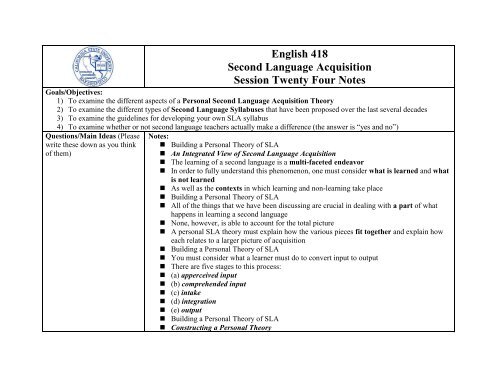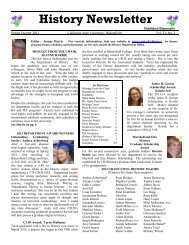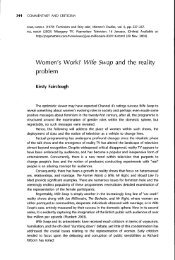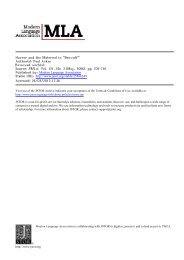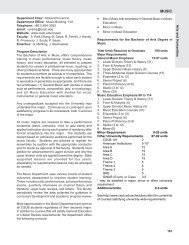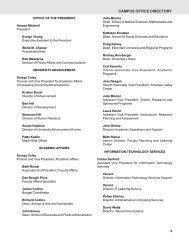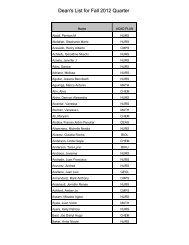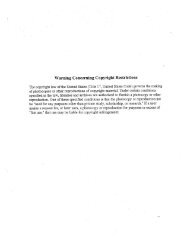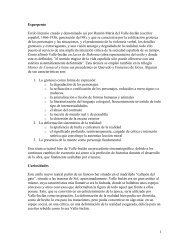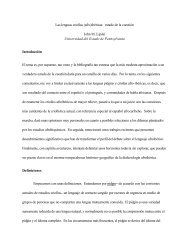English 418 Second Language Acquisition Session Twenty Four ...
English 418 Second Language Acquisition Session Twenty Four ...
English 418 Second Language Acquisition Session Twenty Four ...
Create successful ePaper yourself
Turn your PDF publications into a flip-book with our unique Google optimized e-Paper software.
<strong>English</strong> <strong>418</strong><br />
<strong>Second</strong> <strong>Language</strong> <strong>Acquisition</strong><br />
<strong>Session</strong> <strong>Twenty</strong> <strong>Four</strong> Notes<br />
Goals/Objectives:<br />
1) To examine the different aspects of a Personal <strong>Second</strong> <strong>Language</strong> <strong>Acquisition</strong> Theory<br />
2) To examine the different types of <strong>Second</strong> <strong>Language</strong> Syllabuses that have been proposed over the last several decades<br />
3) To examine the guidelines for developing your own SLA syllabus<br />
4) To examine whether or not second language teachers actually make a difference (the answer is “yes and no”)<br />
Questions/Main Ideas (Please<br />
write these down as you think<br />
of them)<br />
Notes:<br />
• Building a Personal Theory of SLA<br />
• An Integrated View of <strong>Second</strong> <strong>Language</strong> <strong>Acquisition</strong><br />
• The learning of a second language is a multi-faceted endeavor<br />
• In order to fully understand this phenomenon, one must consider what is learned and what<br />
is not learned<br />
• As well as the contexts in which learning and non-learning take place<br />
• Building a Personal Theory of SLA<br />
• All of the things that we have been discussing are crucial in dealing with a part of what<br />
happens in learning a second language<br />
• None, however, is able to account for the total picture<br />
• A personal SLA theory must explain how the various pieces fit together and explain how<br />
each relates to a larger picture of acquisition<br />
• Building a Personal Theory of SLA<br />
• You must consider what a learner must do to convert input to output<br />
• There are five stages to this process:<br />
• (a) apperceived input<br />
• (b) comprehended input<br />
• (c) intake<br />
• (d) integration<br />
• (e) output<br />
• Building a Personal Theory of SLA<br />
• Constructing a Personal Theory
• First: you must decide whether or not acquisition can best be characterized by means of<br />
innateness<br />
• Is it nature or nurture<br />
• Does the learner come to the learning task with an underlying grammar? (Innatism)<br />
• Or does language learning result from social interaction? (Behaviorism)<br />
• Building a Personal Theory of SLA<br />
• Those working within the first paradigm take as the scope of investigation linguistic<br />
descriptions of grammars<br />
• In so doing, an idealized speaker-hearer is assumed, with the claim being made that in order<br />
to fully understand formal constraints on language, one needs to isolate that linguistic<br />
system and investigate it in and of itself without external influences<br />
• Building a Personal Theory of SLA<br />
• In the social interactionist view, language and social interaction cannot be separated without<br />
resulting in a distorted picture of the development of linguistic and interactive skills<br />
• <strong>Language</strong> and cognitive development are deeply embedded in the context<br />
• Thus, understanding the development of syntax, for example, can only come about as one<br />
investigates how syntax interacts with other relevant aspects of language<br />
• Building a Personal Theory of SLA<br />
• These conflicting positions have resulted in the development of different research traditions<br />
as a result of the different questions being asked<br />
• This, in turn, has resulted in conflicting views about the best way to gather data and the<br />
correct questions to be asked<br />
• Building a Personal Theory of SLA<br />
• Next, what is the role of input?<br />
• (Regardless of which perspective above you choose, it is clear that input of some sort is<br />
necessary in order for acquisition to take place)<br />
• We should first note that learners are exposed to a large body of second language data<br />
• Building a Personal Theory of SLA<br />
• A well-established fact about second language acquisition is that not everything that<br />
learners hear/read is used to form internal grammars<br />
• Some data filters through, some does not<br />
• In other words, some data is apperceived, some is not<br />
• The first stage of input utilization is called apperceived input
• Building a Personal Theory of SLA<br />
• Apperception is the process of understanding by which newly observed qualities of an<br />
object are related to past experiences<br />
• In other words, past experiences relate to the selection of what might be called noticed<br />
material<br />
• Apperception is an internal cognitive act, identifying a linguistic form as being related to<br />
some prior knowledge<br />
• Building a Personal Theory of SLA<br />
• You can think of apperception as a priming device that tells us which parameters to attend<br />
to in analyzing second language data<br />
• That is, it is a priming device that prepares the input for further analysis<br />
• What is noticed, then, interacts with a parsing mechanism that attempts to segment the<br />
stream of speech into meaningful units for the learner<br />
• Building a Personal Theory of SLA<br />
• Thus, apperceived input is that bit of language that is noticed in some way by the learner<br />
because of some particular features<br />
• Why are some aspects of language noticed by the learner, whereas others are not?<br />
• What are the mediating factors at this initial stage?<br />
• What factors serve as input filters?<br />
• Building a Personal Theory of SLA<br />
• One obvious factor is frequency<br />
• Something that is very frequent in the input is likely to be noticed<br />
• On the other hand, something that is unusual because of its infrequency may stand out for a<br />
learner<br />
• Building a Personal Theory of SLA<br />
• A second factor that influences apperception is affect<br />
• This category can include such factors as:<br />
• Social distance<br />
• Status<br />
• Motivation<br />
• Attitude<br />
• Building a Personal Theory of SLA<br />
• A third factor that may determine whether language data are apperceived is prior
knowledge<br />
• Learning involves integration of new knowledge with prior knowledge<br />
• One needs some sort of anchor on which to ground new knowledge<br />
• Building a Personal Theory of SLA<br />
• Prior knowledge factors can include:<br />
• Knowledge of the native language<br />
• Existing knowledge of the second language<br />
• Knowledge of other languages<br />
• World knowledge<br />
• <strong>Language</strong> universals<br />
• Building a Personal Theory of SLA<br />
• A final factor is that of attention<br />
• At a given point in time, does a learner attend to the input?<br />
• Attention is important because it allows a learner to notice a mismatch between what he or<br />
she knows about the second language and what is produced by speakers of the second<br />
language<br />
• Building a Personal Theory of SLA<br />
• Input can be apperceived (and is hence comprehensible), but may not be comprehended<br />
• Comprehensible input is controlled by the person providing the input, generally a native<br />
speaker of the language<br />
• Comprehended input is controlled by the learner<br />
• Building a Personal Theory of SLA<br />
• That is, it is the learner who is or who is not doing the “work” to understand<br />
• This distinction is crucial in the eventual relationship to intake, because it is the learner who<br />
ultimately controls that intake<br />
• Building a Personal Theory of SLA<br />
• Apperception can be conceptualized as a priming device<br />
• It prepares the learner for the possibility of subsequent analysis<br />
• In comprehending, however, the task facing the learner is to analyze the input in order to<br />
determine how to incorporate it into their grammars (interlanguage)<br />
• Building a Personal Theory of SLA<br />
• Therefore, there is another separation of components – that of comprehended input and<br />
intake
• This separation is important because not all input that is comprehended becomes intake<br />
• Building a Personal Theory of SLA<br />
• For example, input may be comprehended only for the immediate purpose of a<br />
conversational interaction<br />
• Or it may be used for purposes of learning – where the intake is incorporated into the<br />
learner’s grammar<br />
• Building a Personal Theory of SLA<br />
• In SLA theory, intake refers to the process of attempted integration of linguistic<br />
information<br />
• Thus, input that is only used in a conversation and for the sake of that conversation is not<br />
regarded as intake<br />
• Building a Personal Theory of SLA<br />
• Intake is the process of assimilating linguistic material<br />
• It refers to the mental activity that mediates between input and grammars and is different<br />
from apperception or comprehension as the latter two do not necessarily lead to grammar<br />
formation<br />
• Building a Personal Theory of SLA<br />
• Thus, input and intake refer to two fundamentally different phenomena<br />
• Intake is that component where psycholinguistic processing takes place<br />
• It is where incoming information is matched against prior knowledge<br />
• Building a Personal Theory of SLA<br />
• And where, in general, processing takes place against the backdrop of existing internalized<br />
grammatical rules<br />
• This is the place where generalizations and over-generalizations are likely to occur<br />
• It is where fossilization stems from<br />
• Building a Personal Theory of SLA<br />
• This is the component where several major processes occur, including:<br />
• Hypothesis formation<br />
• Hypothesis testing<br />
• Hypothesis rejection<br />
• Hypothesis modification<br />
• Hypothesis confirmation<br />
• Building a Personal Theory of SLA
• After there is language intake, there are several possible outcomes:<br />
• 1) Hypothesis confirmation/rejection (intake)<br />
• This results in intake<br />
• Building a Personal Theory of SLA<br />
• 2) Apparent non-use<br />
• This stems from the fact that the information contained in the input is already incorporated<br />
into a leaner’s grammar<br />
• This does not preclude it from being used, however<br />
• Building a Personal Theory of SLA<br />
• The additional information may be used for rule strengthening or hypothesis<br />
reconfirmation<br />
• Part of becoming a fluent speaker of a second language involves the automatic retrieval of<br />
information from one’s knowledge base<br />
• Building a Personal Theory of SLA<br />
• Information that may appear to be redundant may in fact be serving an important purpose in<br />
terms of the access a learner has to that information<br />
• 3) Storage – perhaps some level of understanding has taken place, yet it is not clear how to<br />
integration can or should take place<br />
• Building a Personal Theory of SLA<br />
• 4) Non-use<br />
• In this final possibility, learners make no use of the input at all<br />
• This may be because they have not succeeded in comprehending it at a useful level<br />
• Building a Personal Theory of SLA<br />
• Finally, what is the role of output?<br />
• There are two points to emphasize:<br />
• First, there is the role of comprehensible output in the testing out of hypotheses<br />
• This provides a feedback loop back into the intake component<br />
• Building a Personal Theory of SLA<br />
• <strong>Second</strong>, there is the role output plays in forcing a syntactic rather than solely semantic<br />
analysis of language<br />
• This provides a feedback loop to comprehended input<br />
• Thus, output is an active part of the entire learning process<br />
• <strong>Second</strong> <strong>Language</strong> Syllabuses
• <strong>Second</strong> <strong>Language</strong> Instruction<br />
• Does Instructed <strong>Second</strong> <strong>Language</strong> <strong>Acquisition</strong> really make a difference?<br />
• A major goal for studying what we have been studying is to provide a sound<br />
psycholinguistic basis for <strong>Second</strong> <strong>Language</strong> teaching<br />
• But what role does all this theory play?<br />
• <strong>Second</strong> <strong>Language</strong> Instruction<br />
• Evidence from morpheme studies has shown that instruction has little or no effect on the<br />
acquisition order<br />
• Found similar orders of acquisition between naturalistic and instructed settings<br />
• The result was the claim that instruction has little or no effect on the acquisition order of<br />
SLA<br />
• Instruction has been proposed to help SLA in two important ways, however:<br />
• <strong>Second</strong> <strong>Language</strong> Instruction<br />
• 1) Rate of acquisition<br />
• A study by Pienemann (1984) suggests that while it seems impossible to alter the<br />
developmental sequences, it does seem possible that instruction can have a facilitating<br />
effect on the rate of SL learning<br />
• It is in fact in this area that instruction is most clearly beneficial, with empirical support<br />
strong and diverse<br />
• <strong>Second</strong> <strong>Language</strong> Instruction<br />
• Long reviewed eleven studies of the achievement of learners after comparable periods of<br />
classroom instruction, natural exposure, or combinations of the two (called ‘mixed’)<br />
• He found six which clearly showed faster development in children and adults receiving<br />
formal SL teaching, two whose findings, while ambiguous, were arguably in the same<br />
direction, and three which showed minor or no effects for instruction<br />
• <strong>Second</strong> <strong>Language</strong> Instruction<br />
• Weslander and Stephany: report on a large-scale evaluation of “pull-out” ESL for 577 LEP<br />
students (grades two through ten) in public schools in Des Moines, Iowa<br />
• Results showed that children receiving more ESL instruction outperformed those receiving<br />
less instruction on the Bilingual Syntax Measure, with effects being strongest at lower<br />
levels<br />
• Why is it important that we increase the rate of acquisition?
• <strong>Second</strong> <strong>Language</strong> Instruction<br />
• 2) Ultimate Level of Attainment<br />
• Less research in this area, but equally compelling<br />
• Major study done by Pavesi (1984), who compared relative clause formation in instructed<br />
and naturalistic acquirers<br />
• <strong>Second</strong> <strong>Language</strong> Instruction<br />
• The instructed learners were 48 Italian high school students, aged 14 to 18, who had<br />
received from two to seven years of grammar-based EFL instruction, but had had no<br />
informal exposure to <strong>English</strong><br />
• <strong>Second</strong> <strong>Language</strong> Instruction<br />
• The naturalistic acquirers were 38 Italian workers (mostly waiters), aged nineteen to fifty,<br />
in Edinburgh, Scotland, who had received only minimal or (usually) no formal <strong>English</strong><br />
instruction<br />
• Had been in Britain from three months to twenty five years (average of six years), during<br />
which they had been exposed to <strong>English</strong> in a variety of home, work, and recreational<br />
settings<br />
• <strong>Second</strong> <strong>Language</strong> Instruction<br />
• Non-equivalent group design: age discrepancy between groups<br />
• Lower socio-economic levels for naturalistic learners, less education<br />
• On the other hand, balance of exposure to language clearly in favor of naturalistic learners<br />
• Results: High school students outperformed the naturalistic acquirers on virtually every<br />
measure of language attainment<br />
• <strong>Second</strong> <strong>Language</strong> Instruction<br />
• Bottom line: formal SL instruction does not seem able to alter acquisition sequences, except<br />
temporarily and in trivial ways which may even hinder subsequent development<br />
• On the other hand, instruction has positive effects on the rate at which learners acquire the<br />
language, and probably beneficial effects on their ultimate level of attainment<br />
• <strong>Second</strong> <strong>Language</strong> Instruction<br />
• The other bottom line: without it, naturalistic or not, the learning process would simply<br />
never begin, if learners are left to their own devices<br />
• Syllabuses<br />
• Translate decisions into actual teaching units<br />
•
Summary/Minute Paper:


